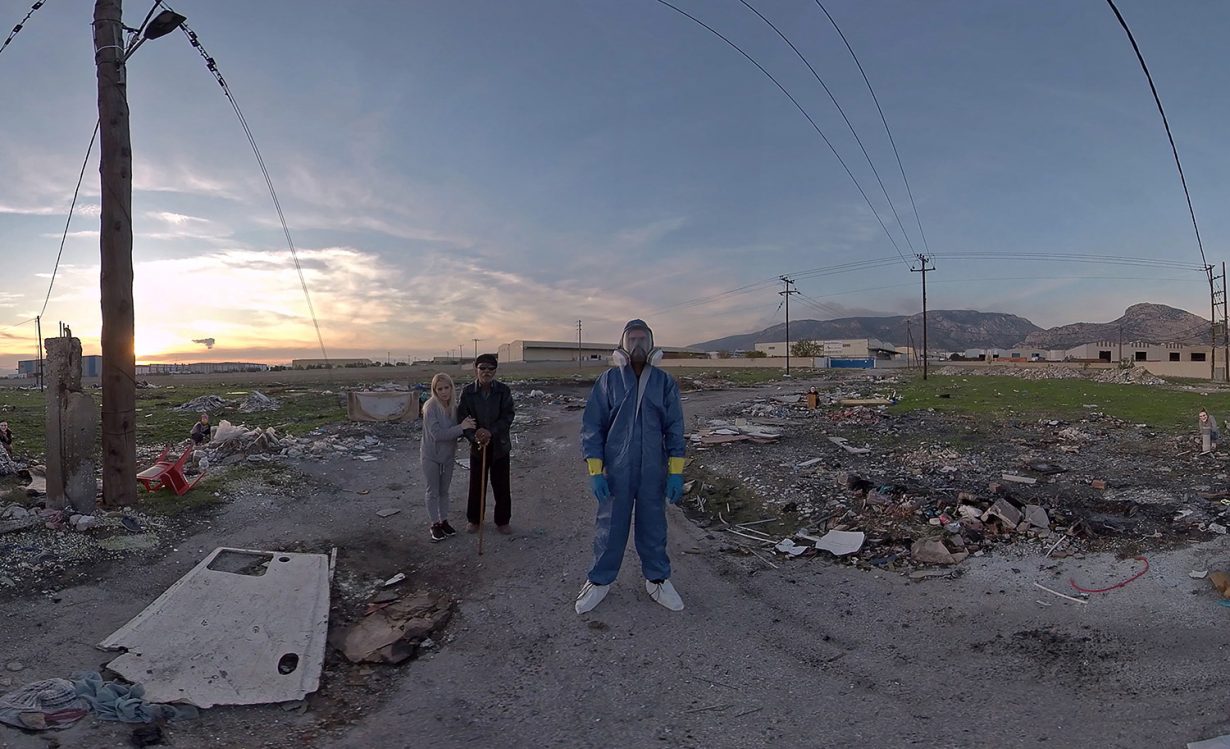
ArtReview sent a questionnaire to artists and curators exhibiting in and curating the various national pavilions of the 2022 Venice Biennale, the responses to which will be published daily in the leadup to the Venice Biennale, opening on 23 April, and over the course of its run.
Loukia Alavanou is representing Greece; the pavilion is in the Giardini.
ArtReview What can you tell us about your exhibition plans for Venice?
Loukia Alavanou The core of the exhibition is a ‘docufictional’ VR film shot in a toxic wasteland, a Romani ghetto in the western outskirts of Athens, which is hardly ever entered by ‘outsiders’. All the actors are Romani amateurs; I spent a year with the community before shooting. The film is based on Oedipus at Colonus by Sophocles, a play about an aged political exile who is looking for a place that will grant him permission to stay and allow him to die peacefully. I felt that the 2,500-year-old play touches on urgent current issues such as ‘exile’, personal freedom, and the quest to be accepted as an outsider.
In the pavilion, we are building a construction based on the utopian ideas of the overlooked Greek architect of the 1960s Takis Zenetos, himself an outsider, who envisioned an electronic city, a ‘cloud colony’ made of hemispherical capsules that would be inhabited by humans who would exist ‘everywhere and nowhere’ at the same time. His ideas about the future forecasted the metaverse and today’s social connections, in my view.


AR Why is the Venice Biennale still important?
LA It is an opportunity to experience works, not only by artists who are huge names and already deep into the market. It can be a great context for a plurality of voices.
AR Do you think there is such a thing as national art? Or is all art universal? What is misunderstood or forgotten about your country’s art history or artistic traditions?
LA I don’t feel comfortable with the term ‘national’; it is the beginning of all evils. On the other hand, it is important to acknowledge artists’ biographical influences that are often inseparable from the cultural context in which they grew up. Greece has a strong tradition of travelling theatre companies, which trace their roots to the ancient tragedian Thespis and existed up until the 1950s. These travelling companies were called bouloukia and were considered ‘low art’. They worked with props and sets they found in the villages they travelled to, in an improvisational way. No documentations of their performances exist. My film is influenced by them in terms of methodology. VR is a medium that bears similarities to theatre; the VR camera does not ‘point a finger’ towards its subject, as in most ethnographical films. On the contrary, it becomes an amphitheatrical stage and it is very inclusive.

AR Which other artists from your country have influenced or inspired you?
LA I consider my installation at the Greek pavilion as an homage not only to the work, but also to the tragic life of Takis Zenetos, an architect who I believe was so far ahead of his time that the conservative Greek society of the ’60s ‘suffocated’ him.
AR How does having a pavilion in Venice make a difference to the art scene in your country?
LA Greece is a country overshadowed by its heritage and often dismissive of its contemporary cultural production; therefore, the pavilion in Venice offers a great opportunity. I believe there is real value in the art scene in Greece, especially by artists of my generation, as we were brought up in the blossoming post-dictatorship years of the early ’80s, during a newly established but still fragile democracy. Greek institutions offer little support and I feel lucky to be one of the youngest artists to ever represent Greece in Venice, especially given that I am a woman and that the country is largely patriarchal.

AR If you’ve been to the biennale before, what’s your earliest or best memory from Venice?
LA I will never forget Tino Sehgal’s This Is So Contemporary, at the German Pavilion, in 2005, where amateur singers who seemed like exhibition guards engaged you into a spontaneous dance that was a caustic critique of the artworld.
AR What else are you looking forward to seeing?
LA I love the theme and title of the main exhibition this year, The Milk of Dreams, and I look forward to seeing works by female artists I’ve never seen before.
The Venice Biennale runs 23 April – 27 November